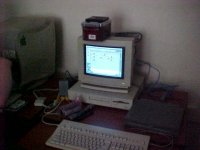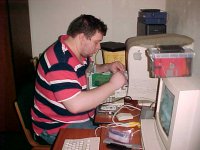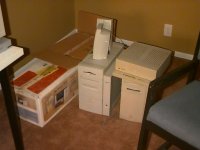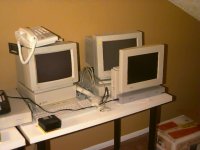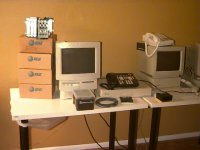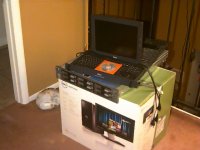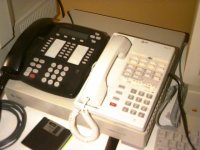This is just a quick appreciation thread for the Apple QuickTake 150 digital camera.
I've had a QuickTake 150 (in box, with the battery pack, the docs, the software, and a few other neat bits) for a bit over a year. Some number of months ago, I put some time into cleaning some battery acid out of it, and just tonight it occurred to me to hook it up with some batteries and shoot some stuff with it.
I'm installing the software onto the PowerBook 180 right now. I've long wanted to take a look at this because the idea of PhotoFlash is pretty intriguing.
One day, I might like to grab a QuickTake 200, and I definitely need to go get the Agfa ActionCam out of my storage locker. I have a Sony Mavica or two (or three?) as well, and those I like because floppy diskettes are a little easier to manipulate in the field than an entire PowerBook.
I will probably eventually designate something a little nicer than the PowerBook 180 as my vintage digital imaging Mac. I'm guessing the work will ultimately go to either the 840av, the 6100, or the beige G3. The 1400 would also work, since it already has a big disk, and I can use CF for backups and file transfers.
I will eventually do a more detailed post with some images and some thoughts on workflow.
I've had a QuickTake 150 (in box, with the battery pack, the docs, the software, and a few other neat bits) for a bit over a year. Some number of months ago, I put some time into cleaning some battery acid out of it, and just tonight it occurred to me to hook it up with some batteries and shoot some stuff with it.
I'm installing the software onto the PowerBook 180 right now. I've long wanted to take a look at this because the idea of PhotoFlash is pretty intriguing.
One day, I might like to grab a QuickTake 200, and I definitely need to go get the Agfa ActionCam out of my storage locker. I have a Sony Mavica or two (or three?) as well, and those I like because floppy diskettes are a little easier to manipulate in the field than an entire PowerBook.
I will probably eventually designate something a little nicer than the PowerBook 180 as my vintage digital imaging Mac. I'm guessing the work will ultimately go to either the 840av, the 6100, or the beige G3. The 1400 would also work, since it already has a big disk, and I can use CF for backups and file transfers.
I will eventually do a more detailed post with some images and some thoughts on workflow.



